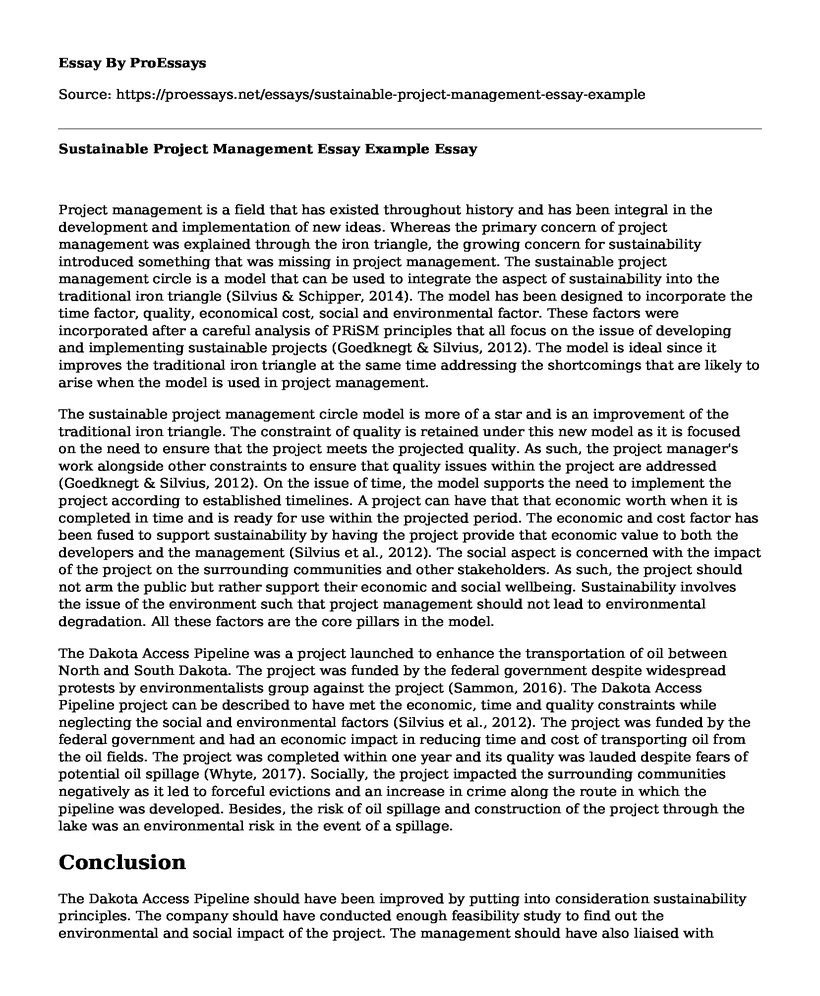Project management is a field that has existed throughout history and has been integral in the development and implementation of new ideas. Whereas the primary concern of project management was explained through the iron triangle, the growing concern for sustainability introduced something that was missing in project management. The sustainable project management circle is a model that can be used to integrate the aspect of sustainability into the traditional iron triangle (Silvius & Schipper, 2014). The model has been designed to incorporate the time factor, quality, economical cost, social and environmental factor. These factors were incorporated after a careful analysis of PRiSM principles that all focus on the issue of developing and implementing sustainable projects (Goedknegt & Silvius, 2012). The model is ideal since it improves the traditional iron triangle at the same time addressing the shortcomings that are likely to arise when the model is used in project management.
The sustainable project management circle model is more of a star and is an improvement of the traditional iron triangle. The constraint of quality is retained under this new model as it is focused on the need to ensure that the project meets the projected quality. As such, the project manager's work alongside other constraints to ensure that quality issues within the project are addressed (Goedknegt & Silvius, 2012). On the issue of time, the model supports the need to implement the project according to established timelines. A project can have that that economic worth when it is completed in time and is ready for use within the projected period. The economic and cost factor has been fused to support sustainability by having the project provide that economic value to both the developers and the management (Silvius et al., 2012). The social aspect is concerned with the impact of the project on the surrounding communities and other stakeholders. As such, the project should not arm the public but rather support their economic and social wellbeing. Sustainability involves the issue of the environment such that project management should not lead to environmental degradation. All these factors are the core pillars in the model.
The Dakota Access Pipeline was a project launched to enhance the transportation of oil between North and South Dakota. The project was funded by the federal government despite widespread protests by environmentalists group against the project (Sammon, 2016). The Dakota Access Pipeline project can be described to have met the economic, time and quality constraints while neglecting the social and environmental factors (Silvius et al., 2012). The project was funded by the federal government and had an economic impact in reducing time and cost of transporting oil from the oil fields. The project was completed within one year and its quality was lauded despite fears of potential oil spillage (Whyte, 2017). Socially, the project impacted the surrounding communities negatively as it led to forceful evictions and an increase in crime along the route in which the pipeline was developed. Besides, the risk of oil spillage and construction of the project through the lake was an environmental risk in the event of a spillage.
Conclusion
The Dakota Access Pipeline should have been improved by putting into consideration sustainability principles. The company should have conducted enough feasibility study to find out the environmental and social impact of the project. The management should have also liaised with various protesting groups to find the best solution that could ensure that the project would be implemented sustainably (Silvius et al., 2012). By considering the social impact and finding better solutions to address the issue, the kind of crimes that occurred during the implementation would have been stopped (Whyte, 2017). Besides, the environmental damage from oil spillage would have been prevented if the principles of sustainable management would have been followed to the later.
References
Goedknegt, D., & Silvius, A. J. G. (2012). The implementation of sustainability principles in project management. In Proceedings of the 26th IPMA World Congress (pp. 875-882).
Sammon, A. (2016). A History of Native Americans Protesting the Dakota Access Pipeline. Mother Jones, 9.
Silvius, G., Schipper, R., Planko, J., Van den Brink J., Kohler, A. (2012) Sustainability in Project Management. Gower Publishing, Ltd
Silvius, A. J., & Schipper, R. P. (2014). Sustainability in project management: A literature review and impact analysis. Social Business, 4(1), 63-96.
Whyte, K. (2017). The Dakota access pipeline, environmental injustice, and US colonialism.
Cite this page
Sustainable Project Management Essay Example. (2022, Nov 04). Retrieved from https://proessays.net/essays/sustainable-project-management-essay-example
If you are the original author of this essay and no longer wish to have it published on the ProEssays website, please click below to request its removal:
- Paper Example on Diversity, High Performing Teams, and Creativity or Innovation
- Big Bark Toys Case Study Paper Example
- Technology Project Implementation: Risks & Responses
- Essay Example on Breach Avoidance: It Can Be Done, It Must Be Done
- Essay Sample on Strategic Planning: Utilizing Systems for Optimal Results
- Paper Example on Network Form & Gender Equity: Examining Life Science Careers
- Free Essay Example on Empowering for Nurses







